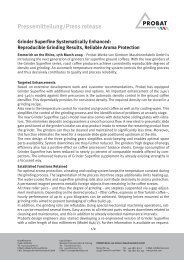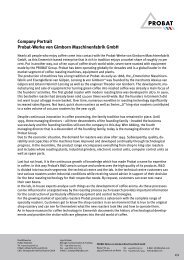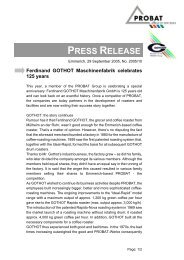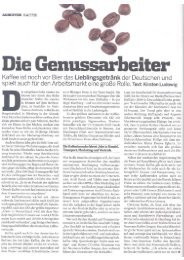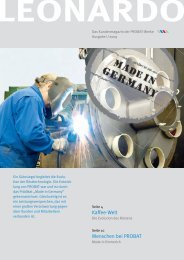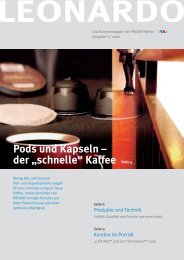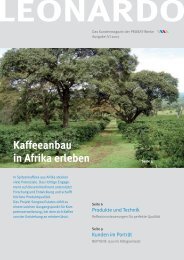leonardo - Probat
leonardo - Probat
leonardo - Probat
You also want an ePaper? Increase the reach of your titles
YUMPU automatically turns print PDFs into web optimized ePapers that Google loves.
Pods, open system<br />
In 2003 the Senseo coffee machine<br />
was also introduced to the German<br />
market. The special pods or respective<br />
single-serve packages ensure the<br />
right mix of coffee powder and water.<br />
Pods, closed system<br />
The slightly different form, for example<br />
Melitta’s „My Cup“: The pods offer<br />
the same convenience and are based<br />
on the shape of a filter bag.<br />
Capsules<br />
Introduced to the Swiss and Italian markets<br />
as early as 1986: Nespresso machines<br />
for capsules. The encapsulated coffee<br />
powder equals the right amount for a cup.<br />
A „quick“ coffee in different variants can<br />
be made using this system too.<br />
Coffee World 04 | 05<br />
to intermediate roasting times, higher extraction rates are achieved influencing<br />
sensory properties towards higher acidity and body.<br />
Of particular importance is the distribution of grain sizes after grinding: This is<br />
dependent upon the degree of grinding as well as the kind of grinding roll used<br />
and is decisive for the coffee’s optics and flavour. PROBAT grinders can achieve<br />
grain size parameters of up to 300 µm and thus conform to pod grinding specifications.<br />
Low grinding temperature conserves the aroma.<br />
The degassing of ground coffee also plays an important role: During roasting<br />
gases develop which escape from the coffee after roasting. Even if this effect<br />
is less evident with older coffee, it never vanishes completely and thus poses<br />
a challenge in coffee packaging, particularly with pods and capsules. Grinding<br />
takes place directly upstream. The ground coffee is not temporarily stored<br />
but directly enters the packaging machine where it is packaged in pods and<br />
capsules. The PROBAT grinders UW 45 L/1, 203, 213 and 225 are particularly<br />
well-suited for an alignment directly above the packaging machines. Their high<br />
precision provides a reproducible and consistent grain spectrum. Using these<br />
grinders, a perfect alignment and adjustment of portioning as well as a variation<br />
of processing performance becomes possible.<br />
The most recent development for single-serve systems – and thus for use on<br />
packaging machines designed roll mills – is the UW 45 L/1.<br />
Because of its low grinding temperatures, the mill not only grinds particularly<br />
aroma-friendly; it also reduces downtimes. Apart from its use as a packaging<br />
machine grinder, this mill offers diverse applications in labs or small roasting<br />
businesses.<br />
•<br />
•<br />
•<br />
Hard pods are usually used for making<br />
espresso. They have a diameter<br />
of 45 to 55 mm and have a charging<br />
capacity of 7 g per cup or 14 g for two<br />
cups. A brewing pressure of between<br />
9 and 19 bar is required.<br />
In contrast, soft pods, which are mostly<br />
used for filter coffee, are, either coated<br />
with filter paper or shrink-wrapped in<br />
thermoplastic foil whereby they are perforated<br />
during preparation. They have a<br />
slightly larger diameter of between 50<br />
and 61 mm and are subjected to a lower<br />
brewing pressure of about 1 to 3 bar. By<br />
the way, soft pods are distinguished<br />
between flat top pods (with a defined<br />
topside for machine processing) and<br />
symmetrical pods.<br />
Capsules can be used for preparing<br />
a very wide spectrum of coffee variations.<br />
Ground coffee is packed in tightly<br />
sealed capsules and is extracted using<br />
coffee-making systems which have an<br />
integrated pump.<br />
Grinder UW 45 L/1



